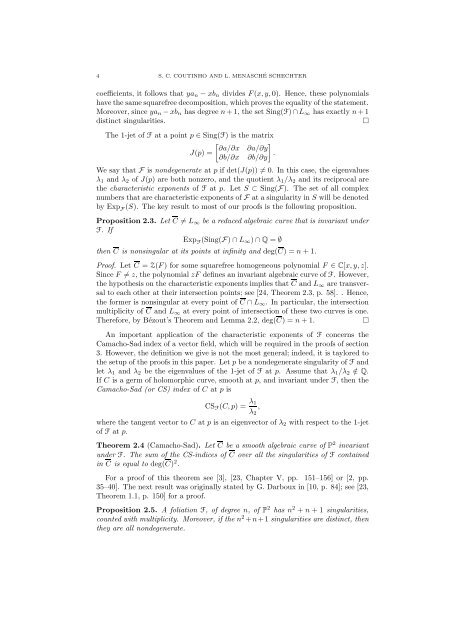ALGEBRAIC SOLUTIONS OF PLANE VECTOR FIELDS ... - dCC-UFRJ
ALGEBRAIC SOLUTIONS OF PLANE VECTOR FIELDS ... - dCC-UFRJ
ALGEBRAIC SOLUTIONS OF PLANE VECTOR FIELDS ... - dCC-UFRJ
You also want an ePaper? Increase the reach of your titles
YUMPU automatically turns print PDFs into web optimized ePapers that Google loves.
4 S. C. COUTINHO AND L. MENASCHÉ SCHECHTER<br />
coefficients, it follows that yan − xbn divides F(x, y, 0). Hence, these polynomials<br />
have the same squarefree decomposition, which proves the equality of the statement.<br />
Moreover, since yan −xbn has degree n+1, the set Sing(F) ∩L∞ has exactly n+1<br />
distinct singularities. <br />
The 1-jet of F at a point p ∈ Sing(F) is the matrix<br />
<br />
∂a/∂x ∂a/∂y<br />
J(p) =<br />
.<br />
∂b/∂x ∂b/∂y<br />
We say that F is nondegenerate at p if det(J(p)) = 0. In this case, the eigenvalues<br />
λ1 and λ2 of J(p) are both nonzero, and the quotient λ1/λ2 and its reciprocal are<br />
the characteristic exponents of F at p. Let S ⊂ Sing(F). The set of all complex<br />
numbers that are characteristic exponents of F at a singularity in S will be denoted<br />
by Exp F(S). The key result to most of our proofs is the following proposition.<br />
Proposition 2.3. Let C = L∞ be a reduced algebraic curve that is invariant under<br />
F. If<br />
Exp F(Sing(F) ∩ L∞) ∩ Q = ∅<br />
then C is nonsingular at its points at infinity and deg(C) = n + 1.<br />
Proof. Let C = Z(F) for some squarefree homogeneous polynomial F ∈ C[x, y, z].<br />
Since F = z, the polynomial zF defines an invariant algebraic curve of F. However,<br />
the hypothesis on the characteristic exponents implies that C and L∞ are transversal<br />
to each other at their intersection points; see [24, Theorem 2.3, p. 58]. . Hence,<br />
the former is nonsingular at every point of C ∩ L∞. In particular, the intersection<br />
multiplicity of C and L∞ at every point of intersection of these two curves is one.<br />
Therefore, by Bézout’s Theorem and Lemma 2.2, deg(C) = n + 1. <br />
An important application of the characteristic exponents of F concerns the<br />
Camacho-Sad index of a vector field, which will be required in the proofs of section<br />
3. However, the definition we give is not the most general; indeed, it is taylored to<br />
the setup of the proofs in this paper. Let p be a nondegenerate singularity of F and<br />
let λ1 and λ2 be the eigenvalues of the 1-jet of F at p. Assume that λ1/λ2 /∈ Q.<br />
If C is a germ of holomorphic curve, smooth at p, and invariant under F, then the<br />
Camacho-Sad (or CS) index of C at p is<br />
CSF(C, p) = λ1<br />
,<br />
where the tangent vector to C at p is an eigenvector of λ2 with respect to the 1-jet<br />
of F at p.<br />
Theorem 2.4 (Camacho-Sad). Let C be a smooth algebraic curve of P 2 invariant<br />
under F. The sum of the CS-indices of C over all the singularities of F contained<br />
in C is equal to deg(C) 2 .<br />
For a proof of this theorem see [3], [23, Chapter V, pp. 151–156] or [2, pp.<br />
35–40]. The next result was originally stated by G. Darboux in [10, p. 84]; see [23,<br />
Theorem 1.1, p. 150] for a proof.<br />
Proposition 2.5. A foliation F, of degree n, of P 2 has n 2 + n + 1 singularities,<br />
counted with multiplicity. Moreover, if the n 2 +n+1 singularities are distinct, then<br />
they are all nondegenerate.<br />
λ2
















